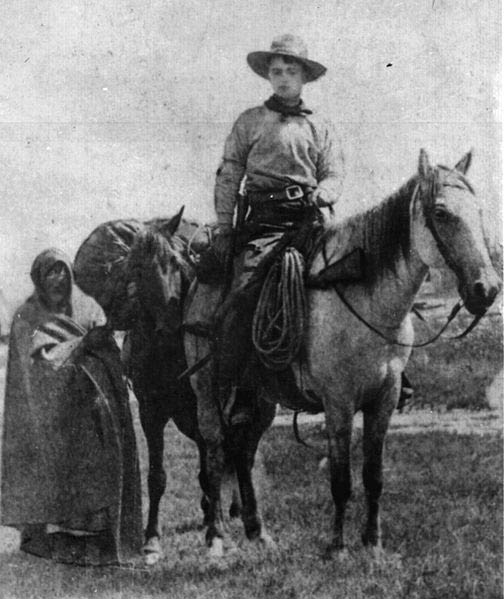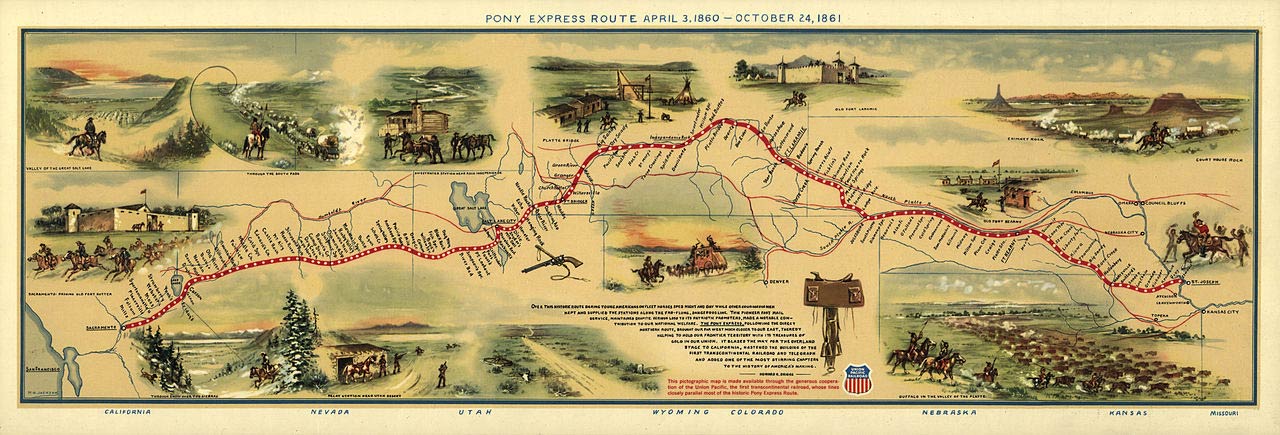 One of the most amazing occurrences in American history was the formation and operation of the Pony Express. Although short in duration, lasting only from April of 1860 to November of 1861, the romance and daring of this enterprise has captured the hearts and imaginations of people ever since. The Pony Express was established by a group of stagecoach operators for the purpose of carrying the mail between San Francisco, California and Saint Joseph, Missouri. The three gentlemen, Daniel E. Phelps, Alexander Majors, and Senator W.M. Gwinn invested in the enterprise because they felt certain that it would be financially successful. Unfortunately, this was to prove untrue.
One of the most amazing occurrences in American history was the formation and operation of the Pony Express. Although short in duration, lasting only from April of 1860 to November of 1861, the romance and daring of this enterprise has captured the hearts and imaginations of people ever since. The Pony Express was established by a group of stagecoach operators for the purpose of carrying the mail between San Francisco, California and Saint Joseph, Missouri. The three gentlemen, Daniel E. Phelps, Alexander Majors, and Senator W.M. Gwinn invested in the enterprise because they felt certain that it would be financially successful. Unfortunately, this was to prove untrue.
Looking for Fast Horses
Preparations for the establishment of the Pony Express included the purchase of 600 tough, fast, strong ponies. The types of mounts used varied; however, they were mostly the small, high endurance mustangs that ran wild on the prairie and had adapted to the harsh conditions of the American wilderness.
Seventy-five riders were hired, each of whom exhibited excellent skills in the areas of horsemanship, shooting, bravery, endurance and knowledge of the ways of the Native Americans they would encounter. Additionally, riders were required to be small and light, not weighing more than 110 pounds. The initial circulars that were distributed to advertise for Pony Express riders read as follows: “Wanted. Young, skinny, wiry fellows. Not over 18. Must be expert riders. Willing to risk death daily. Orphans preferred.”
Plans Going Awry
Although the investors who began the Pony Express had felt that it would be a lucrative commercial enterprise, they didn’t realize how many obstacles and hurdles this precursor of the U.S. Postal System would encounter. Unfortunately, the route the riders were required to take was quite hazardous. Riders were often caught up in the midst of Indian warfare. Additionally, they were quite often attacked by Indians, and on many occasions injured ponies riddled with the arrows straggled into the stations bearing dead riders.

Social Unrest
The reasons for the Indian attacks were many and varied. Of course, the Native Americans were keen on defending their homes against the influx of settlers. Additionally, tensions were high due to Native Americans being used as slave labor in the gold camps and/or attacked and displaced by settlers taking over their land. All-in-all, this made a very dangerous situation for the Pony Express riders. Indeed, many people of the time were of the opinion that the entire undertaking was quite foolhardy due to its inherent danger.
In addition to attacking the riders, the Indians also had a penchant for stealing the bags the riders carried due to the false belief that these bags held magical contents. Indians often raided the stations, looting their contents and killing the station masters. Understandably, these conditions made it very difficult for the Pony Express to keep riders as many quit and many were killed.
Overall, Indian attacks and warfare often brought the delivery of the mail to a screeching halt. Whether it was Indian attacks on the Pony Express itself, warfare between Indians and pioneers or intervention from the Cavalry, the social unrest of the early U.S. wilderness made it extremely difficult for the mail to get through.
Outlaws & Wildlife
In addition to Indian problems, the path of the Pony Express riders was rife with other troubles. Many are either lost life and limb to inclement weather, outlaws and various predatory wildlife and buffalo herds, which posed surprising threats.
In the mid-1800s, buffalo were still in great abundance across the prairies, and the herds were vast. Buffalo were quite unpredictable and tended to stampede easily. Understandably, all the tumult surrounding attempts to carry the mail through their territory kept them quite agitated.
In addition to wildlife, outlaws presented major obstacles to Pony Express riders. They would ambush riders, create roadblocks across the trails, and make off with the mail. It was impossible for stagecoaches to get around outlaws; however, Pony Express riders were expected to be wily and avoid them as much as possible. Unfortunately, corruption within the system made this impossible due to unscrupulous Pony Express employees who sometimes sold the trail times to outlaws and received kickbacks of the stolen loot.
Illness & Injury Posed Constant Threats
Work conditions were indeed harsh for Pony Express riders, and the potential for injury and death was extreme. A horse being ridden hard across dangerous and rugged terrain is always at risk for a broken leg. A horse spooked by a herd of buffalo can easily fly over the edge of a cliff. Many a time, riders were obliged to walk into the next station when their horses met with mayhem.
In fact, this was the case on the very last shipment of mail delivered by the Pony Express. A rider’s horse fell over a steep incline, broke its neck and died causing the rider to have to climb the hill, return to the road and begin the long walk to the station. Luckily, a stagecoach happened by and this last rider carrying the final delivery of Pony Express mail was able to ride to the station.
Political Unrest
In 1860-1861, politics was in turmoil. On the brink of civil war, the U.S. government had many matters on its plate and little time to think about the postal service. In addition to being considered non-essential, the Pony Express was considered impractical. Indeed, many referred to the Pony Express as “the great gamble.” These problems made it close to impossible to get any funding. The majority of people felt that it would be better to postpone mail delivery until a coast to coast railroad system had been established.
Another matter of concern was the telegraph. Congress commissioned $40,000 annually for the stringing of telegraph lines coast-to-coast. This was considered far more practical as a means of communication than hand delivery of letters on horseback. For this reason, establishing a telegraph system took precedence over establishing a postal system.
The Pony Express Financial Fiasco
The three original investors began the enterprise with $700,000 of their own money and $200,000 borrowed. They hoped to obtain a $1,000,000 contract from the U.S. government to establish a U.S. postal service. Unbeknownst to them there were other forces at work that also hoped to gain contracts for mail delivery by rail. This was already a popular choice among most people, and the trials and tribulations and hair-raising experiences the Pony Express riders endured over their 18 months of service made it even more so. Ultimately, all these conditions conspired to drive the enterprise out of business.
The Pony Express, An Icon of the American West
While not a reliable way to deliver the mail, the Pony Express was certainly the fastest mail delivery method when it worked. Although ultimately unsuccessful, the Pony Express left a legacy of high adventure and tall-tales that will surely never be forgotten.